Historical Background to the NAIDOC 2019 Theme: ‘Voice, Treaty, Truth’
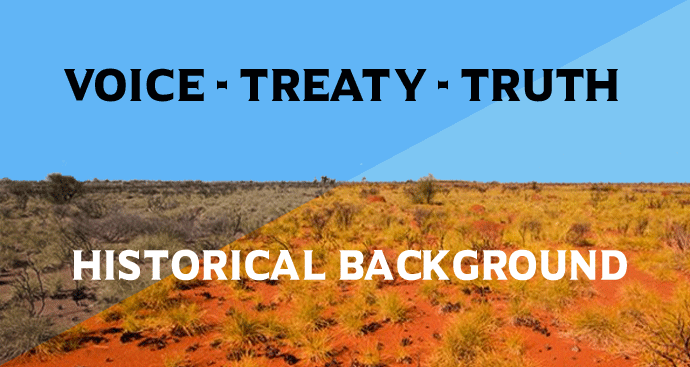
Our greatest fear is not whether we negotiate a Treaty, but the forcing through of the Recognition campaign for inclusion in the colonial Constitution.
We are Sovereign Peoples, always was, always will be. We are NOT Australians. We are who we are. Let them never forget that this is the case.

Ghillar, Michael Anderson, provides an historical insight into the NAIDOC 2019 theme ‘Voice, Treaty, Truth’, which reveals that each time First Nations Sovereignty rises up too powerfully it is suppressed in favour of the ‘trip wire to assimilation’. The ‘Voice’, of the NAC was shafted in 1984; the NAC ‘Treaty’ framework was dismantled and ‘Truth’ has barely been heard yet.
In 1972 the Federal opposition leader, the late Gough Whitlam, and the member for Canberra, the late Kep Enderby MP, came to the Aboriginal Embassy and sat with us where we had talks about progressing Aboriginal Affairs. Mr Whitlam congratulated us on our bold political action and recognised that our presence had focused the attention of the world on an historical dispute and confrontation that had been silently raging since 1788.
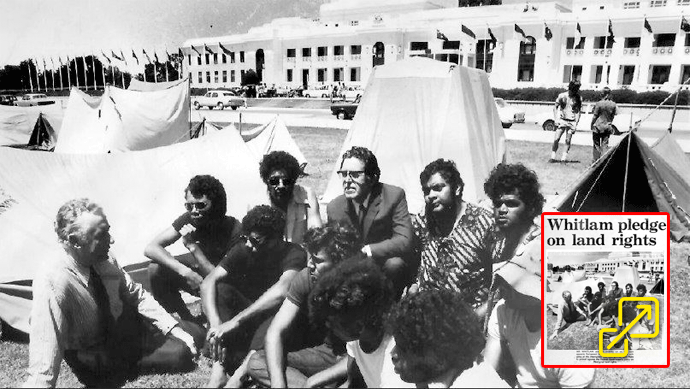
Click image to view newspaper clipping
I recall Whitlam stating that while the Embassy focused attention the time had come when, if he were elected at the end of 1972, he would initiate a process to establish a Voice through a democratically elected Aboriginal body to give directions and policy advice to the national parliament on locating solutions to unresolved issues. The outcome was that 12 months later in 1973 we had the first Black Parliament elected by popular vote, the National Aboriginal Consultative Committee (NACC). Australia was divided up into 36 regions and 36 Aboriginal people were elected by their own people to be the Voice to Parliament. Within two years of these elections, the Whitlam government was sacked by the Queen’s representative, the then Governor-General Sir John Kerr, but not before Whitlam had introduced the Racial Discrimination Act 1975, in~ response, to end the practice that Whitlam detested of Bjelke-Peterson’s government in Queensland, where, despite the success of the 1967 Referendum, the Bjelke-Peterson government still had prison commandants controlling and confining First Nations people to mission stations, such as Palm Island, Woorabinda and Cherbourg.
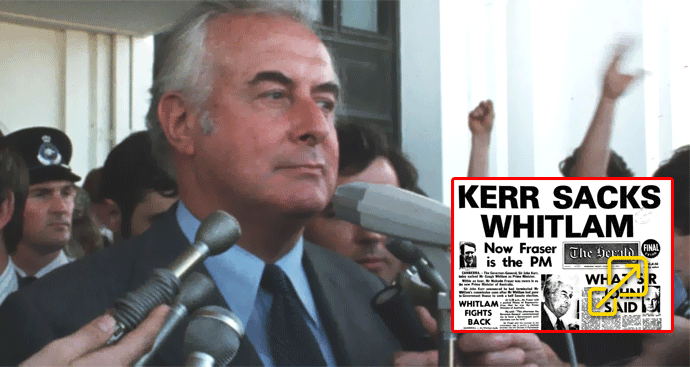
Click image to view newspaper clipping
The Whitlam government was sacked by the Queen’s representative, the then Governor-General Sir John Kerr, but not before Whitlam had introduced the Racial Discrimination Act 1975'
Kep Enderby MP, on the other hand, a very conscientious social justice advocate, together with PM Whitlam, found it hard to accept that Aboriginal Peoples on mission stations had no legal right of appeal to any other court within Australia once a decision had been made by a specially appointed magistrate to those mission stations. It was not until 1977 that the Bjelke-Peterson government withdrew these commandants controlling the missions and freed the people from the vices of the colonial system.
History now shows that there were State parliamentary commitments made that Aboriginal people, once freed, could be liberated back to their own Country from whence they came. Queensland historical papers show that when they forcibly removed the people from their homelands they called it ‘deportation’.
In 1975 Whitlam also introduced the Northern Territory Land Rights legislation into the national parliament because the Commonwealth had the power to pass legislation for the Northern Territory and the ACT.
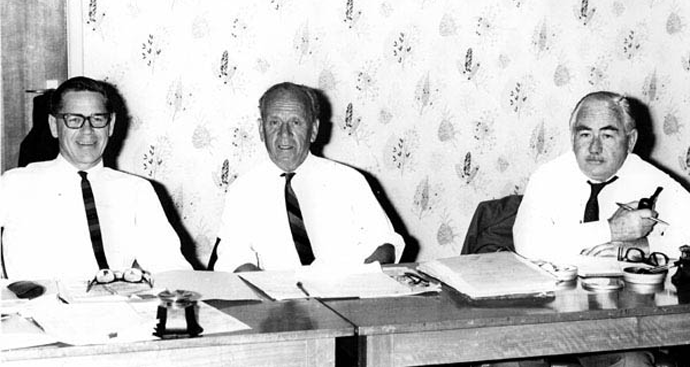
Barrie Dexter, Herbert Cole 'Nugget' Coombs, William Edward Hanley Stanner
I am aware of the National Aboriginal Consultative Committee’s (NACC) advice to the Whitlam government about getting land back from the States. To this end the national Parliament increased a budget appropriation to the Aboriginal Land Fund, which at that time was still controlled by Dr HC ‘Nugget’ Coombs, Professor Bill Stanner, Jeremy Long and Barrie Dexter. Unfortunately for us in the south-east of Australia, we missed out on some major acquisitions, because Nugget Coombs’ primary focus was the NT, WA and SA. The elected body was proactive in raising political matters such as ‘Sovereignty never ceded’ and the formulation of a Treaty framework. These matters were being pushed by the late brother Bruce McGuinness in Victoria, Phillip Hall in New South Wales, and Steve Mam in Queensland.
With the election of PM Malcolm Fraser’s government, Lois O’Donoghue (aka Lowitja) found a friend in Fred Chaney, who was the principal legal solicitor for the Aboriginal Legal Service in Perth, Western Australia that he helped to found in 1973, prior to being elected as a Liberal Senator for Western Australia in 1974. Lowitja informed the hard right of the Liberal Party that the Aboriginal men were making decisions in bars and clubs without a balanced input from women. To this end, Nugget Coombs and Lowitja O’Donoghue were appointed by the government to write up these complaints, which at the end of the day saw the NACC of Aboriginal elected people dismissed by the government. The terms of reference for their future operations were laid down by Nugget Coombs and Lowitja O’Donoghue and structured to avoid issues of sovereignty and treaty.
As a consequence of Nugget Coombs’ inquiry, a new body was elected under the name of the National Aboriginal Conference (NAC) to which Lowitja O’Donoghue was elected from South Australia.
In 1979 the NAC voted to send Mr Reg Birch of the Kimberley to the UN Human Rights Committee in Geneva to highlight the military being used to force the Sovereign Peoples of Noonkanbah out of the way of an oil drilling company on their land. This move by the NAC struck enormous fear into the hearts and minds of Australia’s elected politicians.
Under the leadership of the Chair, Bill Bird from Sydney, the NAC became actively involved in international issues on First Nations rights and decolonisation, which resulted in the late Cedric Jacobs, a Wadjuk man from WA, and myself being sent by the NAC to the first world conference on the rights of the World’s First Nations Peoples hosted by the UN in Geneva in July 1981. The delegation of Cedric Jacobs and myself in 1981 made the government realise that First Nations Peoples here in Australia had reached the point which said: ‘Enough is enough’.
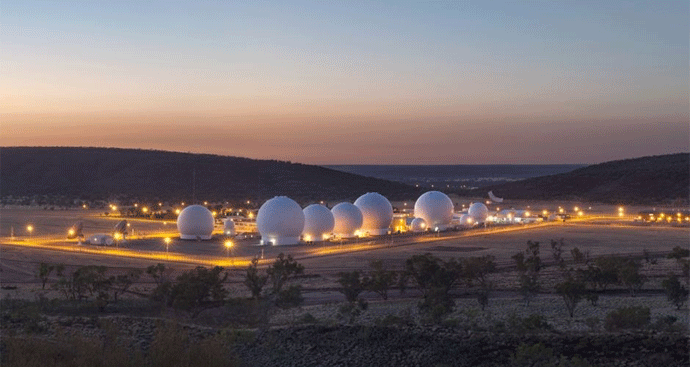 Australian and American military strategies involved in the acquisition of land, within or adjacent to, already existing Aboriginal Homelands throughout the north and west, coupled with the American and Australian military complex in the centre of Australia, which controls, to this day, America’s Over-the-Horizon-Radar system that now allows for America to fly its drones on the opposite side of the world.
Australian and American military strategies involved in the acquisition of land, within or adjacent to, already existing Aboriginal Homelands throughout the north and west, coupled with the American and Australian military complex in the centre of Australia, which controls, to this day, America’s Over-the-Horizon-Radar system that now allows for America to fly its drones on the opposite side of the world. On our way to Geneva in July 1981, I was informed in no uncertain terms in an Ottawa motel in Canada, that I was not to go to Geneva and that I had to return to Australia and that Cedric Jacobs was to go on and deliver the NAC presentation. I learnt from the non-Aboriginal journalist, Peter O’Brien, travelling with us that Cedric Jacobs and Bill Bird were commanded by the Minister for Aboriginal Affairs, Peter Baume, and the Attorney-General’s office to delete certain information in the three-page presentation, approved by the executive of the NAC, but it was redacted the night before the NAC was leaving for the UN.
Having written this paper in consultation with the NAC executive, I can recall the redacted sections, which centred around risks associated with future Land Rights for First Nations Peoples in Australia. These issues were: Australian and American military strategies involved in the acquisition of land, within or adjacent to, already existing Aboriginal Homelands throughout the north and west, coupled with the American and Australian military complex in the centre of Australia, which controls, to this day, America’s Over-the-Horizon-Radar system that now allows for America to fly its drones on the opposite side of the world. The NAC’s concern was that, in the event of a first strike by some rogue government, Aboriginal Peoples would be the first to feel the wrath of those bombs. Our People do not know of the dangers that lurk within the shadows of their communities.
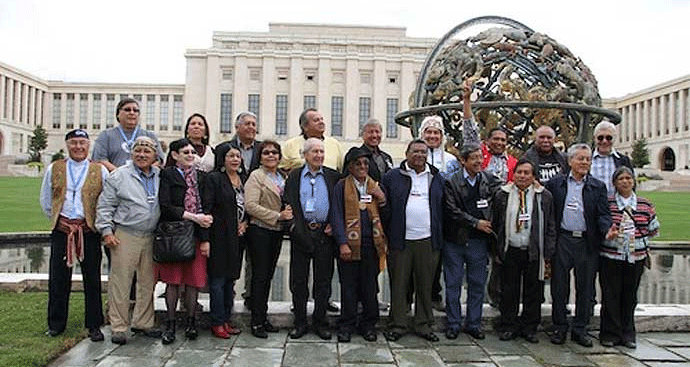
Historical Symposium on Indigenous Peoples at the United Nations, Geneva
Ghillar Michael Anderson (back row 2nd from right)
Fortunately, I persisted on travelling to the UN, but had to be given UN protection in Geneva to avoid being placed under house arrest by the Federal Australian Police on my arrival in Geneva. I was collected at the airport in Geneva by the Secretary of the UN Commission on Human Rights, the late Wiliam Daes, who gave me a secure escort to the Palais de Nations, where I was afforded the right to be the first to present to the UN-sponsored World Conference on First Nations, from which the Working Group on Indigenous populations, and later Indigenous Peoples (WGIP), was formed.
On my return to Canberra, I was appointed by the NAC to be the national Research Director for the formulation of a national treaty framework between the Commonwealth government and the NAC representing Aboriginal Australia.
The NAC, in consultation with the Prime Minister’s office, sent me around the world to look at the experiences, operations and outcomes of other treaties between the colonising States and First Nations Peoples. Moreover, I was privileged to be shown the workings of the Act of Union in Britain between Scotland, Ireland, Wales and England, which created a United Kingdom under one Crown.
In 1983, the NAC executive resolved to send a delegation to five former British colonies, namely Kenya, Nigeria, Tanzania, Zimbabwe and India. During our stopover in Tanzania, we were met by the Foreign Affairs Minister who sought a briefing from us on the matters that the delegation was seeking to discuss.
The Australian and international media were never informed of the true nature of this diplomatic delegation and so conjectured on the local media that the NAC was going to these African States to seek a boycott of the upcoming Commonwealth Games in Brisbane. In fact, no suggestion of a boycott was raised. Our objective was to gain support from these African Nations to raise our matter of an independent arbiter and independent observers being appointed by the Commonwealth Heads of Government (CHOGM) to oversight the Treaty negotiations in Australia and to raise matters within the UN in respect of Britain and Australia’s obligations to decolonise as per the UN Charter and the Decolonisation Committee’s terms of reference.
I might add that the fear of the Australian government became very noticeable after the success of this diplomatic mission. From this point on, the fears expressed in 1981 by Peter Baume and the Liberal government, started to become a reality. The Government Solicitor’s advice to the Commonwealth and the Department of Aboriginal Affairs (DAA) was that ‘that word Treaty’ must be avoided at all costs. The issue of ‘Sovereignty never ceded’ was the thin ice that the Australian government was treading on, and so began a new phase in engaging Aboriginal people to run interference against the NAC and the NAC’s treaty objectives.
This new Black opposition was created by none other than Dr HC Nugget Coombs when he convened a meeting of NAC opposition and created a national opposition called the Federation of Aboriginal Land Councils, which they argued would be more able and equipped to represent Aboriginal people at the grassroots if they organised and broke up the continent into regional sectors. By establishing these Land Councils throughout Australia they would pick community representatives to sit on these Councils, but what these handpicked community-based representatives were not informed about was that they were to stand as an opposition to the NAC’s assertion of Sovereignty.
The NAC was infiltrated by Land Council supporters at the highest level to the point where the 1983 Senate Standing Committee on Constitutional and Legal Affairs was informed by these infiltrators, supported by the Federation of Land Councils, that the continuing sovereignty of First Nations was no longer an issue and that the Treaty was now becoming obsolete.
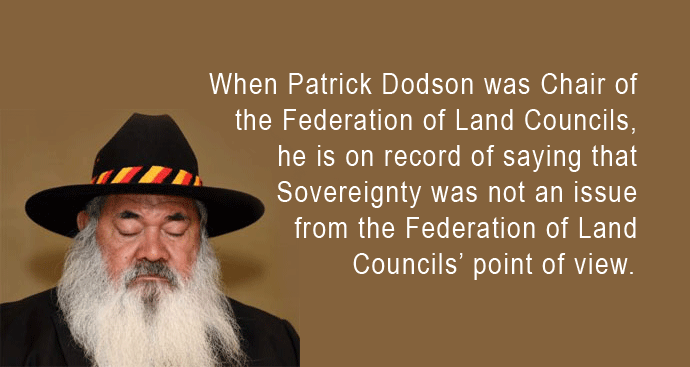
Patrick Dodson, Chair of the Federation of Land Councils, is on record at the Alice Springs hearing of the Senate Standing Committee on Constitutional and Legal Affairs that Sovereignty was not an issue from the Federation of Land Councils’ point of view. The successful political coup within the NAC to oust Lyall Munro Snr as the Chair saw the first act by the new Chair, Rob Riley, who flew on the red-eye flight from Perth straight after being elected Chair, to meet the Minister for Aboriginal Affairs, the late Clyde Holding. Riley informed the Minister that the Treaty itself was also off the agenda. The late Mr Riley also orchestrated, with the assistance of Minister Holding, to appear before the Senate Standing Committee on Constitutional and Legal Affairs in Canberra, where he advised them that the pre-condition to negotiating a Treaty on the question of ‘Sovereignty never ceded’ would no longer be pursued and that the Treaty name would not come back, but a lesser agreement would be discussed under a Makaratta.
The volatility of the politics of the NAC in 1984 had reached boiling point and to this end Clyde Holding, Minister for Aboriginal Affairs, appointed a three-person committee to review the purpose and terms of reference of the NAC. The review team consisted of two sitting NAC reps, Mr Patrick Malone of Queensland, Ms Lowitja O’Donoghue of South Australia and was headed by the late Nugget Coombs. After the review was complete, the recommendations were to dismantle the NAC, the Aboriginal Development Commission (ADC) and the Department of Aboriginal Affairs (DAA) and create, by federal statute, the Aboriginal and Torres Strait Islander Commission (ATSIC).
It should be noted, that under the leadership of Chair, Geoff Clark, ATSIC attempted to resurrect discussions on a Treaty and it was within a short space of time after ATSIC hosted a Convention on a Treaty in Canberra, that ATSIC’s short 10-year life was terminated.
So the question now is: Who is truly running the agenda for a treaty (or treaties) and what are the underlying ‘trip wires to assimilation’.
Another question that has to be asked is: Who will truly benefit from such an action if Sovereignty is not an issue?
Let me remind you:
Native Title is designed to take away more than it gives. Indigenous Land Use Agreements (ILUAs) are designed for you all to validate past land grants to non-Aboriginal people and thereby invalidate the extinguishment First Nations’ sovereign title to land. The draft constitutional referendum for First Nations’ inclusion in the Australian Constitution is cleverly worded so that the heart strings and conscience of the public are being played like a harp to engender sympathy and ‘doing right’, without explaining the true underlying evil and devilish agenda of assimilating us through a blind ‘good deed’ of the public.
There is a right way and the ones leading the way are those who are standing up the right way and are the People who still live on Country and still have connection to their Law and Culture.
Our greatest fear is not whether we negotiate a Treaty or not, but the forcing through and playing on the public’s mind to do right by First Nations through the Recognition campaign for inclusion in the colonial Constitution.
There is another way, and I call upon our younger people to lift your heads and fight the fight that we must have. We are Sovereign Peoples, always was, always will be. We are NOT Australians. We are who we are. Let them never forget that this is the case.
 Contact: Ghillar Michael Anderson
Contact: Ghillar Michael AndersonConvenor of the Sovereign Union,
Head of State of the Euahlayi Peoples Republic
Contact Details here
NAIDOC 2019 videos – Ballina and Narromine Schools invite Ghillar to talk truth to them:
Are you ready for the truth?: YOUTUBE or VIMEO (HD)
Truth-telling: Flags and Treaties: YOUTUBE or VIMEO (HD)
More background information :



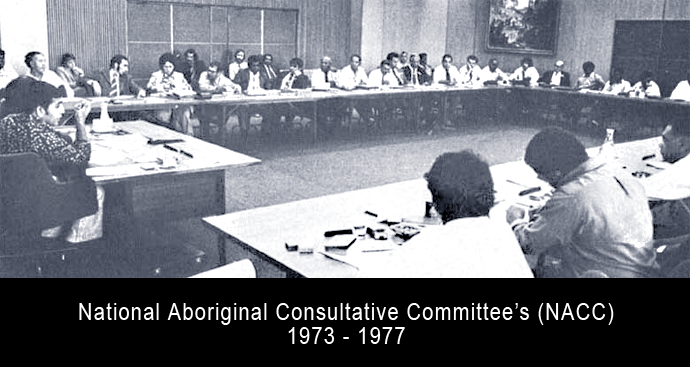 National Aboriginal Consultative Committee’s (NACC) 1973 - 1977
National Aboriginal Consultative Committee’s (NACC) 1973 - 1977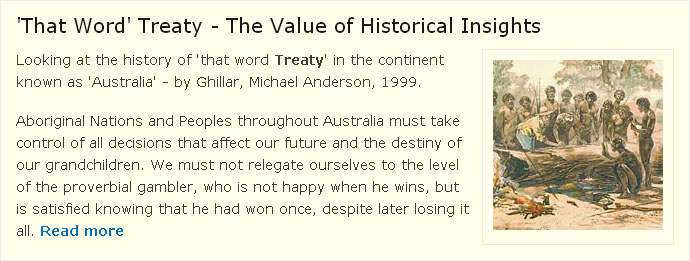 That word Treaty - Go to page
That word Treaty - Go to page